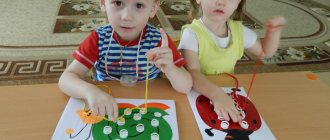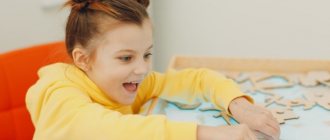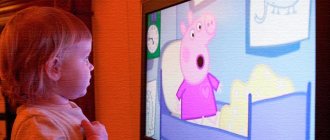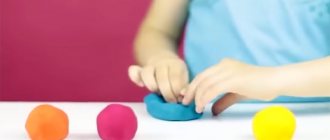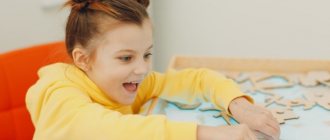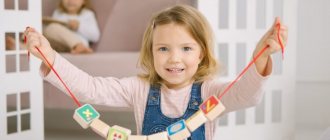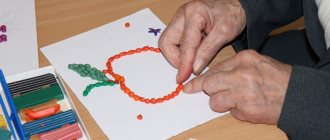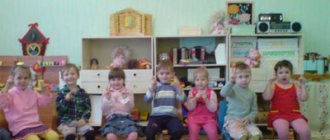Greetings, dear parents!
It is difficult to imagine the modern full life of any person without normal free movements of all parts of the body. The ability to manage and control them.
Quite often we hear and read that the development of fine motor skills is important for a small child, but we do not attach the necessary importance, and sometimes we completely forget about the importance of gross motor skills.
Or we are trying to develop the child intellectually and spend less time in active games, which is very important for a growing organism. These are our main misconceptions.
Gross motor skills, because it is the basic basis of all our full-fledged movements, and then we can coordinate them more accurately by developing fine motor skills.
Difficulties faced by a child with gross motor deficits
- problems with mastering drawing and writing skills;
- writing or drawing for long periods of time;
- daily self-care skills (dressing yourself, using cutlery);
- maintaining a posture while sitting on the floor or at a desk;
- clumsiness (frequently falls, trips, or crashes into furniture or people);
- low energy level (often appears tired or lethargic, slow to respond to stimuli);
- poor articulation of sounds;
- difficulty manipulating small toys and utensils;
- cannot transfer the skill to a new activity (for example, it is difficult to switch if after a large ball you need to catch a small one or vice versa);
- low self-esteem and difficulties with peers.
Modeling for the development of tactile sensations
Plasticineography is actively used in preschool and school institutions; it is an effective method for developing motor skills and stimulating thought processes at home. Making plasticine figures with children is exciting and at the same time useful.
Plasticineography has an alternative in the form of modeling from salt dough, which is suitable for very young children. This is a natural, and therefore safe, material that contains only three ingredients: water, flour and salt. Modeling supports sensorimotor development in children.
Why are these skills important?
By helping your child develop gross motor skills independently or with the help of specialists, you:
- increase your child’s confidence in his movements (running, jumping, outdoor games);
- help your child develop the strength and endurance needed to cope with the pressures of the school day;
- Provide your child with a stable base to use their arms and hands more effectively to perform fine motor skills (manipulating small objects such as pencils, scissors, keys, buttons and zippers);
- support his self-esteem by giving him the opportunity to participate in joint games with other children;
- increase athletic abilities (participation in sports events, not necessarily professional ones, enriches the child’s social life and provides an opportunity to establish new friendships).
Svetlana Aleksandrovna Plakhova is a neuropsychologist who helps children in the development and correction of cognitive functions, using the wide range of possibilities that neuropsychology offers. Together with speech therapist L.A. Poplavskaya are the authors and presenters of special preparation for school for children with learning difficulties.
| School preparation program for children with learning difficulties>> |
Fine motor skills: what is it? Recommendations for the development of motor skills.
Many modern mothers and fathers have already become familiar with the concept of “fine motor skills.” Trying to positively influence the child’s development, parents persistently give their children sorters and finger mazes, and with older children they draw and sculpt all day long.
But how do you know if the actions taken are correct? Is the degree of exercise appropriate for the baby’s age and do the exercises bring the desired effect? To answer these and other questions, you should take a closer look at the topic of developing fine motor skills.
General concept
Motor skills are a set of body movements performed under the control of the body’s psychological reactions. The motor processes that a person possesses give an idea of the level of development of his coordination and intelligence.
Psychologists classify physical activity, identifying several types:
— General, or gross, motor skills are responsible for the movements of muscle groups. An example of such an activity is running or squatting.
- Fine motor skills - movements of the hands or fingers. Developed motor reactions of the hands help us lace up our shoes or lock the door. Fine motor skills include actions in which it is necessary to combine eye and hand movements, as in drawing, for example.
— Articulatory motor skills are the ability to coordinate the work of the speech apparatus, that is, to speak.
A little physiology
While studying issues of child psychology and pedagogy, scientists came to stunning conclusions. It turns out that about a third of the cerebral cortex is responsible for the development of hand motor skills. In addition, this third is located as close as possible to the speech center. A comparison of these facts gave grounds to consider the motor activity of the hands and fingers to be responsible for human speech.
In this regard, the development of fine motor skills in the hands of a young child is one of the fundamental tasks in teaching speech skills. Of course, along with improving articulatory activity. The results of many years of experience prove that the scientists’ conclusions were correct.
In addition to the above dependence, fine motor skills have a direct impact on the formation of logic, thinking skills, strengthening memory, training observation, imagination and coordination. Children who have better control over their hands show perseverance and tire more slowly.
Fine motor development calendar
At every age, a child is capable of performing certain actions. New opportunities appear as his nervous system matures. Each new achievement appears due to the fact that the previous skill was successfully mastered, so the level of motor skills formation must be monitored.
- 0-4 months - the child can coordinate eye movements, tries to reach objects with his hands. If you manage to pick up a toy, then the squeezing of the hand occurs, rather, due to reflexes that fade away up to six months. The baby does not yet have dominant preferences that allow him to perform actions with a more “comfortable” hand, and they will not appear soon - he is still both “right-handed” and “left-handed.”
- 4 months - a year - the child’s skills are actively improving, now he can transfer objects from hand to hand, perform simple actions such as turning pages. Now the baby can grab even a small bead with two fingers.
- 1-2 years - movements become more and more confident, now the child uses the index finger more actively. The first drawing skills appear - the baby draws dots and circles, and soon he will be able to draw a line on a sheet of paper with a pencil. Now he begins to prefer one hand over the other.
- 2-3 years - hand motor skills allow you to hold scissors and even cut paper with them. The drawing style changes along with the way the pencil is held, and the first conscious figures appear on the sheet of paper.
- 3-4 years - the child already draws confidently and knows how to cut a sheet along the drawn line. He has already decided on his dominant hand, but in games he skillfully uses both. Your child will soon be able to hold a pen or pencil just like an adult, so by age 4 he will be ready to learn writing skills.
- 4-5 years. Fine hand motor skills in children of this age already resemble the movements of adults. Please note: when drawing or coloring, the child does not move the whole hand at once, but only the brush. The movements are more refined, so cutting out an object from paper or coloring without going beyond the contours is no longer so difficult.
- 5-6 years. At this age, a preschooler’s hands should be perfectly coordinated; the child already holds a pen with three fingers, draws small details like an adult, and knows how to use scissors. All the baby's skills indicate that he will not experience difficulties at school.
Low level of motor development - what does this mean?
Insufficiently formed hand motor skills impede not only the development of speech skills. Such a child may experience problems with memory and logic.
If this is a preschooler, then he urgently needs help, because he will be absolutely unprepared for school. Such a student will have difficulty concentrating, will become tired quickly and will inevitably begin to fall behind. When and how to start working with your baby? From birth you can begin to pay attention to the development of the baby. Of course, a newborn will not be interested in a sorter or a toy with lacing. But you can start putting rattles in his hand, let him touch fabrics of different textures with his fingers, give the baby a hand massage. The age at which active development of finger motor skills is important is 8 months. If up to this point no attention has been paid to this issue, now is the time to take some action. Exercises To organize real activities with your own baby, a mother does not need professional teaching skills. For exercises, the simplest objects that can always be found in any home are suitable. The main principle on which the development of hand motor skills is built is “from big to small.” What does this mean? — Start rolling plasticine balls with your child. Let the baby make something. If he can do this, he can gradually move on to smaller and more complex details. - You can just tear the paper. First into large pieces, then into small ones. The finer the details, the higher the level of development of motor skills in the child. — Together with your child, you can string beads onto a thread, tie shoelaces, and fasten buttons. Passive gymnastics (massage) A competent massage therapist is an excellent assistant in developing a child’s coordination. An experienced specialist will also help with the motor skills of the baby’s hands. You can start classes already in the first 3-4 months of the child, and sessions can be conducted for 5 minutes up to several times a day. It is better to entrust massage sessions to a professional, but if necessary, some exercises can be performed independently. So, you need to stroke the baby’s hands for a minute, then rub them lightly. Then perform vibrating taps with your fingers on your hands and palms. Another effective massage exercise is bending and straightening your fingers and then massaging each one. Toys Toys for hand motor skills are sold in large quantities in children's goods stores. They even come with instructions indicating the recommended age and a description of the game process. But you don't have to buy anything. You can play with any objects - almost any thing in the house (safe for the child) is suitable for developing motor skills. A hand-made board for developing motor skills, or a busy board using the Montessori method, is an excellent gift for a child aged 1 to 3 years. Dad could make such a toy. To do this, you will need a sheet of plywood and the most dangerous items in the house: a socket with a plug, furniture fittings, switches, latches and other household parts. The point of the toy is for the child to learn such things in their safe form. After getting acquainted with the socket on the stand, the baby will not become interested in the real one, and by feeling these objects with his fingers, he will develop finger motor skills. If your beloved child is already 3 years old, then you can offer a game of “Cinderella”. To do this, various cereals or legumes are poured into a bag, and the child is given the task of sorting through everything. Why not play a guessing game? You can blindfold your baby and take turns placing household items in his hands - let him guess them. In addition, the child will approve of mosaic games, finger theater, and joint appliqués. Helping your beloved child improve himself is not at all difficult, the main thing is to slightly use your own imagination.
Sign up by phone. +7 (8412) 44-44-71
Many modern mothers and fathers have already become familiar with the concept of “fine motor skills.” Trying to positively influence the child’s development, parents persistently give their children sorters and finger mazes, and with older children they draw and sculpt all day long. But how do you know if the actions taken are correct? Is the degree of exercise appropriate for the baby’s age and do the exercises bring the desired effect? To answer these and other questions, you should take a closer look at the topic of developing fine motor skills. The general concept of motor skills is a set of body movements performed under the control of the body’s psychological reactions. The motor processes that a person possesses give an idea of the level of development of his coordination and intelligence. Psychologists classify motor activity, identifying several types: - General, or gross, motor skills are responsible for the movements of a muscle group. An example of such an activity is running or squatting. - Fine motor skills - movements of the hands or fingers. Developed motor reactions of the hands help us lace up our shoes or lock the door. Fine motor skills include actions in which it is necessary to combine eye and hand movements, as in drawing, for example. — Articulatory motor skills are the ability to coordinate the work of the speech apparatus, that is, to speak. A little physiology While studying issues of child psychology and pedagogy, scientists came to stunning conclusions. It turns out that about a third of the cerebral cortex is responsible for the development of hand motor skills. In addition, this third is located as close as possible to the speech center. A comparison of these facts gave grounds to consider the motor activity of the hands and fingers to be responsible for human speech. In this regard, the development of fine motor skills in the hands of a young child is one of the fundamental tasks in teaching speech skills. Of course, along with improving articulatory activity. The results of many years of experience prove that the scientists’ conclusions were correct. In addition to the above dependence, fine motor skills have a direct impact on the formation of logic, thinking skills, strengthening memory, training observation, imagination and coordination. Children who have better control over their hands show perseverance and tire more slowly. Calendar for the development of fine motor skills At every age, a child is able to perform certain actions. New opportunities appear as his nervous system matures. Each new achievement appears due to the fact that the previous skill was successfully mastered, so the level of motor skills formation must be monitored. - 0-4 months - the child can coordinate eye movements, tries to reach objects with his hands. If you manage to pick up a toy, then the squeezing of the hand occurs, rather, due to reflexes that fade away up to six months. The baby does not yet have dominant preferences that allow him to perform actions with a more “comfortable” hand, and they will not appear soon - he is still both “right-handed” and “left-handed.” - 4 months - a year - the child’s skills are actively improving, now he can transfer objects from hand to hand, perform simple actions such as turning pages. Now the baby can grab even a small bead with two fingers. - 1-2 years - movements become more and more confident, now the child uses the index finger more actively. The first drawing skills appear - the baby draws dots and circles, and soon he will be able to draw a line on a sheet of paper with a pencil. Now he begins to prefer one hand over the other. - 2-3 years - hand motor skills allow you to hold scissors and even cut paper with them. The drawing style changes along with the way the pencil is held, and the first conscious figures appear on the sheet of paper. - 3-4 years - the child already draws confidently and knows how to cut a sheet along the drawn line. He has already decided on his dominant hand, but in games he skillfully uses both. Your child will soon be able to hold a pen or pencil just like an adult, so by age 4 he will be ready to learn writing skills. - 4-5 years. Fine hand motor skills in children of this age already resemble the movements of adults. Please note: when drawing or coloring, the child does not move the whole hand at once, but only the brush. The movements are more refined, so cutting out an object from paper or coloring without going beyond the contours is no longer so difficult. - 5-6 years. At this age, a preschooler’s hands should be perfectly coordinated; the child already holds a pen with three fingers, draws small details like an adult, and knows how to use scissors. All the baby's skills indicate that he will not experience difficulties at school. Low level of motor development - what does this mean? Insufficiently formed hand motor skills impede not only the development of speech skills. Such a child may experience problems with memory and logic. If this is a preschooler, then he urgently needs help, because he will be absolutely unprepared for school. Such a student will have difficulty concentrating, will become tired quickly and will inevitably begin to fall behind. When and how to start working with your baby? From birth you can begin to pay attention to the development of the baby. Of course, a newborn will not be interested in a sorter or a toy with lacing. But you can start putting rattles in his hand, let him touch fabrics of different textures with his fingers, give the baby a hand massage. The age at which active development of finger motor skills is important is 8 months. If up to this point no attention has been paid to this issue, now is the time to take some action. Exercises To organize real activities with your own baby, a mother does not need professional teaching skills. For exercises, the simplest objects that can always be found in any home are suitable. The main principle on which the development of hand motor skills is built is “from big to small.” What does this mean? — Start rolling plasticine balls with your child. Let the baby make something. If he can do this, he can gradually move on to smaller and more complex details. - You can just tear the paper. First into large pieces, then into small ones. The finer the details, the higher the level of development of motor skills in the child. — Together with your child, you can string beads onto a thread, tie shoelaces, and fasten buttons. Passive gymnastics (massage) A competent massage therapist is an excellent assistant in developing a child’s coordination. An experienced specialist will also help with the motor skills of the baby’s hands. You can start classes already in the first 3-4 months of the child, and sessions can be conducted for 5 minutes up to several times a day. It is better to entrust massage sessions to a professional, but if necessary, some exercises can be performed independently. So, you need to stroke the baby’s hands for a minute, then rub them lightly. Then perform vibrating taps with your fingers on your hands and palms. Another effective massage exercise is bending and straightening your fingers and then massaging each one. Toys Toys for hand motor skills are sold in large quantities in children's goods stores. They even come with instructions indicating the recommended age and a description of the game process. But you don't have to buy anything. You can play with any objects - almost any thing in the house (safe for the child) is suitable for developing motor skills. A hand-made board for developing motor skills, or a busy board using the Montessori method, is an excellent gift for a child aged 1 to 3 years. Dad could make such a toy. To do this, you will need a sheet of plywood and the most dangerous items in the house: a socket with a plug, furniture fittings, switches, latches and other household parts. The point of the toy is for the child to learn such things in their safe form. After getting acquainted with the socket on the stand, the baby will not become interested in the real one, and by feeling these objects with his fingers, he will develop finger motor skills. If your beloved child is already 3 years old, then you can offer a game of “Cinderella”. To do this, various cereals or legumes are poured into a bag, and the child is given the task of sorting through everything. Why not play a guessing game? You can blindfold your baby and take turns placing household items in his hands - let him guess them. In addition, the child will approve of mosaic games, finger theater, and joint appliqués. Helping your beloved child improve himself is not at all difficult, the main thing is to slightly use your own imagination. Sign up by phone.
How can you help your child?
- we remember and draw “classics” on the asphalt.
- We offer different ways of moving, for example: backwards like a crab or sideways like a sea crab, like a clubfooted bear, moving like a “wheelbarrow” on your hands (an adult holds the child’s legs suspended), etc.;
- create games on unstable surfaces (suggest, for example, to climb over large pillows, look for treasure, or even let your child jump on the bed J);
- don’t forget about all kinds of ball games (with big ones, airy ones, small ones).
- arrange obstacle courses (arrange several objects so that the child needs to go around them, jump over them, crawl under them, climb over them) this allows you to combine the use of a variety of motor skills in one game;
- Games on children's playgrounds, with swinging bridges, nets, ropes, various stairs, descents and ascents are great;
- Swimming will also be useful.
Diagnostics
To determine motor development disorders, diagnostics are required. A specialist will determine its exact results, but parents can assess the situation on their own at home. To do this, you need to unobtrusively ask the child to perform exercises of this type:
- read a fairy tale, making simple movements with your hands, and then invite the child to repeat it;
- extend both arms in front of the chest, clench one palm into a fist, slowly change the position of the hands;
- exercises for fingers: the child takes steps with the middle and index fingers;
- alternately bend the fingers on the upper limbs and straighten them in the reverse order;
- connect your fingers, depicting the beak of a bird, do the exercise on both hands in turn;
- disassemble the pyramid and ask the child to assemble it themselves;
- offer to draw a copy of the house;
- trace the drawing along the dotted lines;
- decorate the figure without protruding beyond the contours.
Children 3 (three) years old are allowed to perform 30% or more of the exercises listed above. A five-year-old child should do 80-90% of the tasks. At lower scores, special training is required to develop fine motor skills.
Caution for parents.
Physical activity is very important for your child's health. But you need to keep in mind that the baby still has some stamina and strength. Keep the activity going for a short period of time, usually about a few minutes, and stop at the first sign of your baby's fatigue. Both babies and toddlers naturally enjoy physical activity and love learning new things. These are the things they can do with their bodies.
